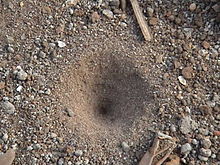The angle of repose or the critical angle of repose,of a granular material is the steepest angle of descent or dip relative to the horizontal plane to which a material can be piled without slumping. At this angle, the material on the slope face is on the verge of sliding. The angle of repose can range from 0° to 90°. Smooth, rounded sand grains cannot be piled as steeply as can rough, interlocking sands. If a small amount of water is able to bridge the gaps between particles, electrostatic attraction of the water to mineral surfaces will increase soil strength.
When bulk granular materials are poured onto a horizontal surface, a conical pile will form. The internal angle between the surface of the pile and the horizontal surface is known as the angle of repose and is related to the density, surface area and shapes of the particles, and the coefficient of friction of the material. However, a 2011 study shows that the angle of repose is also gravity-dependent. Material with a low angle of repose forms flatter piles than material with a high angle of repose.

Contents
- 1 Applications of theory
- 2 Measurement
- 3 Exploitation by antlion and wormlion (Vermileonidae) larvae
- 4 Methods in determining the angle of repose
- 4.1 Tilting box method
- 4.2 Fixed funnel method
- 4.3 Revolving cylinder method
- 5 Angle of repose of various materials
Applications of theory
- The angle of repose is sometimes used in the design of equipment for the processing of particulate solids. For example, it may be used to design an appropriate hopper or silo to store the material, or to size a conveyor belt for transporting the material. It can also be used in determining whether or not a slope (of a stockpile, or uncompacted gravel bank, for example) will likely collapse; thetalus slope is derived from angle of repose and represents the steepest slope a pile of granular material will take. This angle of repose is also crucial in correctly calculating stability in vessels.It is also commonly used by mountaineers as a factor in analysing avalanchedanger in mountainous areas.
Measurement
There are numerous methods for measuring angle of repose and each produces slightly different results. Results are also sensitive to the exact methodology of the experimenter. As a result, data from different labs are not always comparable. One method is the triaxial shear test, another is the direct shear test.If the coefficient of static friction is known of a material, then a good approximation of the angle of repose can be made with the following function. This function is somewhat accurate for piles where individual objects in the pile are minuscule and piled in random order.where, μs is the coefficient of static friction, and θ is the angle of repose.Exploitation by antlion and wormlion (Vermileonidae) larvae

- The larvae of the antlions and the unrelated wormlions Vermileonidae trap small insects such as ants by digging conical pits in loose sand, such that the slope of the walls is effectively at the critical angle of repose for the sand. They achieve this by flinging the loose sand out of the pit and permitting the sand to settle at its critical angle of repose as it falls back. Thus, when a small insect, commonly an ant, blunders into the pit, its weight causes the sand to collapse below it, drawing the victim toward the center where the predator that dug the pit lies in wait under a thin layer of loose sand. The larva assists this process by vigorously flicking sand out from the center of the pit when it detects a disturbance. This undermines the pit walls and causes them to collapse toward the center. The sand that the larva flings also pelts the prey with so much loose, rolling material as to prevent it from getting any foothold on the easier slopes that the initial collapse of the slope has presented. The combined effect is to bring the prey down to within grasp of the larva, which then can inject venom and digestive fluids.
